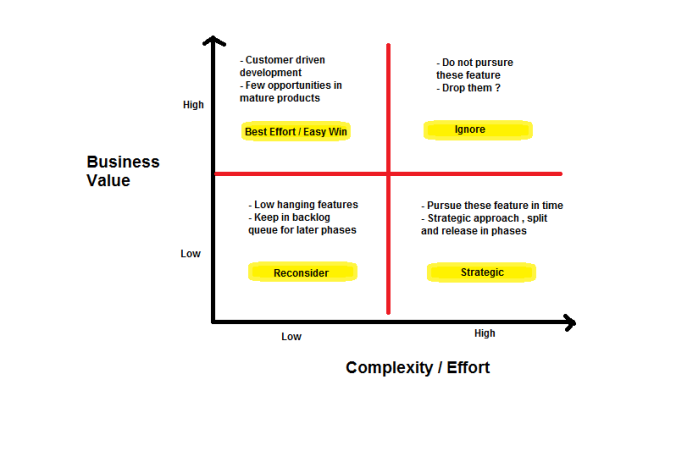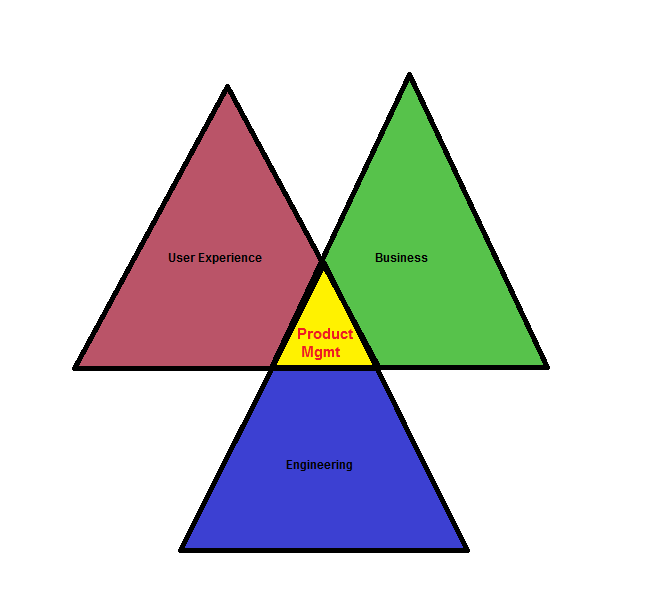Being a ProdEv in professional world doesn’t allow me to promote just the product I work on or any other product or technology I use in my daily life.
Evangelism for me comes from the role of product manager I play in my everyday life . Normally while working with agile product teams , prioritization is the hottest topic during product planning as team working under Agile methodology has to follow sprints (weekly , bi-weekly , monthly) in order to deliver the features for the product to the customer base.
For my today’s topic I am going to list out the behind the scenes work and process that goes into strategizing and prioritizing the product roadmap.
Whether you’re developing a new product or maintaining a mature product , there are several techniques/strategies which can be used to determine the best initiatives.
1.Value vs Complexity Matrix
This model will evaluate every opportunity based on its business value and its relative complexity to implement

A very common approach and it helps determine the initiatives that have the highest value and lowest effort of your roadmap . With backlog prioritization these are the item are to be considered on which phase they can belong to.
2. Weighted Scoring
The basis of this technique starts with value vs complexity model , but by using a scoring method to rank the strategic initiatives , one can facilitate a more productive discussion about what to include on the product roadmap. 
A clear obective scoring model can inform the initiatives you decide to include in one’s product roadmap and lend credibility to the product strategy. Now-a days tools like Product Plan have good usability features where drag and drop functionality makes it easier to construct the roadmap
3. Kano Model (Customer Delight vs Product function)
This model helps to take a look at potential features through the lens of delight a feature will provide to customers against the potential effort or investment that is needed to improve the feature.

The features in a product can be categorized in
- Basic features – the ones that are needed in product in order to sell the product in market
- Threshold features – investing in these wont improve the customer delight drastically.
- Performance features – ones that give a proportionate increase in customer satisfaction as they are invested
- Excitement features – ones that will yield a disproportionate increase in customer delight. These features are something that the customer might not be missing in the product but investing in them will create a dramatic customer delight
4. Buy a feature
This is an activity which can be used wit customers or stakeholders to prioritize a set of potential features. A fun approach where you list out potential features and assign price to each (based on relative cost to develop it). Hand out a set amount of cash and ask the participants to buy the features. The end result if a prioritized feature list
5. Opportunity Scoring
This technique is a type of Gap Analysis that comes from Outcome – Driven Innovation. The idea is to measure and rank opportunities based in their importance vs the customer satisfaction.
To conduct this technique , PMs can ask the customers to score the importance of each feature and score how satisfied they are currently with that feature.
Best opportunities lies with features that are highly important yet customers gave a low satisfaction score and these features should be considered in the product roadmap .
6. Affinity Grouping
This is another fun prioritization activity where everyone (product team) brainstorms opportunities on sticky notes and then as a team being to group similar items together and name the groups. Finally the team votes or ranks on the groups .
7. Story Mapping
This technique is a great way to document a MVP by organizing and prioritizing user stories.
- First one creates task oriented story cards and groups them in a workflow.
- Then you arrange the cards in priority for each group
- The final step is to draw a line across all stories to divide them into releases/sprints
Few pointers regardless of the strategies used
- Prioritization should be approached as a team activity as it brings in different perspectives
- Limit the items to be priortized
- Categorize and group features into strategic themes
- Understand the customer value for each feature
- Rough estimate of cost always helps.
Even as the product team debates on which strategy should be used in order to prioritize feature for the roadmap , how can the team make sure they are prioritizing features that will really hit the target??
I follow a 4-step framework to gather the features that should be considered for prioritization in the roadmap.
1. Gather Actionable Data
Rather than prioritizing features based on opinion , I use a data informed approach. There are 5 steps (followed by a master list of all issues found or reported that will turn into potential product features , fixes and action items )
- Product analytics – Identifying specific steps in the product workflow were customers are getting stuck and leaving instead of taking the action I want them to take ( also helps with the goal of user retention for the product)
- Mouse Tracking analytics – Records what people do with their mouse which will give me insights into where users are paying attention in the product.
- One Page surveys – To find out whats stopping people from performing a specific action ( helpful in case of consumer based websites )
- Support transcripts – Dig into the support transcripts to find out why customers are reaching out or asking for help. Also digging into production customer reported bugs will give an insight into things which can be fixed.
- User Testing – Observe current and potential user interaction with the product while they speak their thought process out and loud. User session recording also lend an insight to how the users use the product.
These steps will help analyze where users get stuck or frustrated , where people aren’t doing what I want them to do and where things need to be improved.
2. Identify the highest value features
Once I have gathered all the quantitative and qualitative data , I have a big list of product issues and ideas.
First I think through each of the potential opportunities and use the Complexity vs Value matrix to come up with the segregated list high value items I can put my vote one when applying strategies as a team.
3. Scoring the features
Once I weed out all the potential opportunities that dont provide strategic value , I score my remaining initiatives.
Main points taken into consideration for scoring are
- Benefit Received
- Cost to Implement
This scoring model isnt the only factor that helps in deciding which features to prioritize – there are other factors like competition , market , customers that need to be taken into consideration as well.
4. Get Stakeholder Buy-In
First thing I do is I walk my stakeholders and team through the process I used to prioritize the product roadmap. I bring in the gathered real evidence about the product from both exiting as well as potential customers. I also back up the prioritization decision with the metric hard data, video clips from user sessions , direct quotes from customers. I also tie my the priorities into organization’s strategic goals by mentioning how it is going to impact the bottom line and enhance the KPI’s our organization cares about
Regardless of which prioritization technique is used in the end , the technique you choose isn’t as important as the conversation with your stakeholders and your team to showcase that priorities are aligned with the strategic goals of the organization.
References
- Product Roadmap Prioritization: Weighted Scoring or the Kano Model?(https://280group.com/product-management-blog/product-roadmap-prioritization-weighted-scoring-kano-model/)
- Kano model and it’s role improving user experience (https://justux.me/kano-model-and-its-role-improving-user-experience-901eaa38f48d)
- User Story Mapping (http://jpattonassociates.com/user-story-mapping/)

